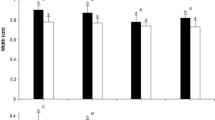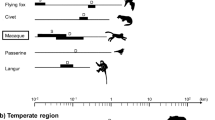Abstract
The large African primates that eat fruit destroy the seeds of a number of fruiting species. This paper addresses several questions about seed-eating: What is the nature of the dietary niche provided by the nonpoisonous seeds of eastern and southern Africa? How well are these seeds mechanically protected? What other means of reducing seed predation are employed by the plants? and is the niche ecologically stable? Measurements of seed shell strength on 37 species from 17 families reveal a range of values, from <100-kg (numerous species) to over 2000-kg (palm nuts) breaking load. Primates crack open with their teeth seed shells from species exhibiting test strengths less than 600 kg. Variation in shell strength appears to increase dramatically for average species strengths above 100 kg. Plant species are not characterized by specific shell strengths but instead, display envelopes of shell strength overlapping broadly with other species. Taking this into account, adult male baboons (Papio spp.) appear to be dentally capable of preying upon most of the seed species of eastern and southern Africa. The possibility for predation of nonpoisonous seeds exists primarily because the plants periodically produce large crops in synchrony and the hard-shelled seeds are effectively dispersed, sometimes explosively but more often by means of edible fruits. The concomitant primate seed predation is a facultative specialization, of little apparent threat to the community of plants that support it.
Similar content being viewed by others
References
Altmann, S. A., Post, D. G., and Klein, D. F. (1987). Nutrients and toxins of plants in Amboseli, Kenya.Afr. J. Ecol. 25: 279–293.
Arnold, T. H., Wells, M. J., and Wehmeyer, A. S. (1985). Khoisan food plants: Taxa with potential for future economic exploitation. In Wickens, G. E., Goodin, J. R. and Field, D. V. (eds.),Plants for Arid Lands Royal Botanic Gardens, Kew, pp. 69–86.
Chism, J., and Rowell, T. E. (1988). The natural history of patas monkeys. In Gautier-Hion, A., Bourliere, F., Gautier, J.-P., and Kingdon, J. (eds.),A Primate Radiation: Evolutionary Biology of the African Guenons, Cambridge University Press, Cambridge, pp. 79–103.
Dalziel, J. M. (1955).The Useful Plants of West Tropical Africa (Appendix to Flora of West Tropical Africa), Crown Agents for Overseas Government and Administrations, London.
Fanshawe, D. B. (1967). The vegetable ivory palm (Hyphaene ventricosa Kirk) its ecology, silviculture and utilisation.Kirkia 6(1): 105–117.
Grine, F. E. (1986). Dental evidence for dietary differences inAustralopithecus andParanthropus: A quantitative analysis of permanent molar microwear.J. Hum. Evol. 15: 783–822.
Janzen, D. H. (1974). The role of the seed predator guild in a tropical deciduous forest, with some reflections on tropical biological control. In Jones, D. P., and Solomon, M. E. (eds.),Biology in Pest and Disease Control, Blackwell, Oxford, pp. 3–14.
Janzen, D. H. (1978). Seeding patterns of tropical trees. In Tomlinson, P. B., and Zimmermann, M. H. (eds.),Tropical Trees as Living Systems, Cambridge University Press, Cambridge, pp. 83–128.
Jolly, C. J. (1970). The seed eaters: A new model of hominid differentiation based on a baboon analogy.Man(NS) 5: 5–26.
Glover, P. E., Stewart, J., and Gwynne, M. D. (1966a). Masai and Kipsigis notes on East African plants: Part I.E. Afr. Agr. Forest. J. 32: 184–191.
Glover, P. E., Stewart, J., and Gwynne, M. D. (1966b). Masai and Kipsigis notes on East African plants: Part II.E. Afr. Agr. Forest. J. 32: 192–199.
Maguire, B. (1978).The Food Plants of the !Khu Bushmen of North Eastern S.W. Africa, Master of science thesis, University of the Witwatersrand, Johannesburg.
Marshall, L. (1976).The !Kung of Nyae Nyae, Harvard University Press, Cambridge, Mass.
Moss, H. (1988).Under-Exploited Food Plants in Botswana, Food and Agriculture Organization of the United Nations, Rome.
Nishida, T., and Uehara, S. (1983). Natural diet of chimpanzees (Pan troglodytes schweinfurthii): Long-term record from the Mahale Mountains, Tanzania.Afr. Stud. Monogr. 3: 109–130.
Norton, G. W., Rhine, R. J., Wynn, G. W. and Wynn, R. D. (1987). Baboon diet: A five-year study of stability and variability in the plant feeding and habitat of the yellow baboons (Papio cynocephalus) of Mikumi National Park, Tanzania.Folia Primatol. 48: 78–120.
Palmer, E., and Pitman, N. (1972).Trees of Southern Africa (3 Vols.), A. A. Balkema, Cape Town.
Peters, C. R. (1982). Electron-optical microscopic study of incipient dental microdamage from experimental seed and bone crushing.Am. J. Phys. Anthropol. 57: 283–301.
Peters, C. R. (1987a). Nut-like oil seeds: Food for monkeys, chimpanzees, humans, and probably ape-men.Am. J. Phys. Anthropol. 73: 333–363.
Peters, C. R. (1987b).Ricinodendron rautanenii (Euphorbiaceae): Zambezian wild food plant for all seasons.Econ. Bot. 41(4): 494–502.
Peters, C. R. (1988). Notes on the distribution and relative abundance ofSclerocarya birrea (A. Rich.) Hochst. (Anacardiaceae).Monogr. Syst. Bot. Missouri Bot. Gard.25: 403–410.
Peters, C. R., and Maguire, B. (1981). Wild plant foods of the Makapansgat area: A modern ecosystems analogue forAustralopithecus africanus adaptations.J. Hum. Evol. 10: 565–583.
Peters, C. R., O'Brien, E. M., and Box, E. O. (1984). Plant types and seasonality of wild-plant foods, Tanzania to southwestern Africa: Resources for models of the natural environment.J. Hum. Evol. 13: 397–414.
Peters, C. R., O'Brien, E. M., and Drummond, R. B. (1992).Edible Wild Plants of Subsaharan Africa: An Annotated Checklist, Emphasizing the Woodland and Savanna Floras of Eastern and Southern Africa, Including the Plants Utilized for Food by Chimpanzees and Baboons, Royal Botanic Gardens, Kew.
Post, D. G., Hausfater, G., and McCuskey, S. A. (1980). Feeding behavior of yellow baboons (Papio cynocephalus): Relationship to age, gender and dominance rank.Folia Primatol. 34: 170–195.
Rhoades, D. F., and Cates, R. G. (1976). Toward a general theory of plant antiherbivore chemistry.Recent Adv. Phytochem. 10: 168–213.
Rodin, R. J. (1985).The Ethnobotany of the Kwanyama Ovambos, Monographs in Systematic Botany, Vol. 9, Missouri Botanical Gardens, St. Louis.
Scudder, T. (1971).Gathering Among African Woodland Savannah Cultivators. A Case Study: The Gwembe Tonga, Zambian Papers5, Institute for African Studies, University of Zambia, Lusaka.
Suzuki, A. (1969). Ecological study of chimpanzees.Primates 10: 103–148.
Tregold, M. H. (1986).Food Plants of Zimbabwe, Mambo Press, Gweru.
Van Lawick-Goodall, J. (1968). The behaviour of free-living chimpanzees in the Gombe Stream Reserve,Anim. Behav. Monogr. 1(3): 161–311.
Van Wyk, P. (1984).Field Guide to the Trees of the Kruger National Park, C. Struik, Cape Town.
Verdcourt, B., and Trump, E. C. (1969).Common Poisonous Plants of East Africa, Collins, London.
Waser, P. (1977). Feeding, ranging and group size in the mangabeyCercocebus albigena. In Clutton-Brock, T. H. (ed.),Primate Ecology—Studies of Feeding and Ranging Behavior in Lemurs, Monkeys and Apes, Academic Press, London, pp. 183–222.
Watt, J. M., and Breyer-Brandwijk, M. G. (1962).The Medicinal and Poisonous Plants of Southern and Eastern Africa, E. and S. Livingstone, Edinburgh.
Wehmeyer, A. S. (1986).Edible Wild Plants of Southern Africa: Data on the Nutrient Contents of Over 300 Species. CSIR, National Food Research Institute, Pretoria.
White, F. (1981). The history of the Afromontane archipelago and the scientific need for its conservation.Afr. J. Ecol. 19: 33–54.
White, F. (1983).The Vegetation of Africa, UNESCO, Paris.
Whitten, P. L. (1988). Effects of patch quality and feeding subgroup size on feeding success in Vervet monkeys (Cercopithecus aethiops).Behaviour 105: 35–52.
Wickens, G. E. (1982). The baobab: Africa's upside-down tree.Kew Bull. 37(2): 173–209.
Author information
Authors and Affiliations
Rights and permissions
About this article
Cite this article
Peters, C.R. Shell strength and primate seed predation of nontoxic species in eastern and southern Africa. International Journal of Primatology 14, 315–344 (1993). https://doi.org/10.1007/BF02192636
Received:
Accepted:
Issue Date:
DOI: https://doi.org/10.1007/BF02192636




